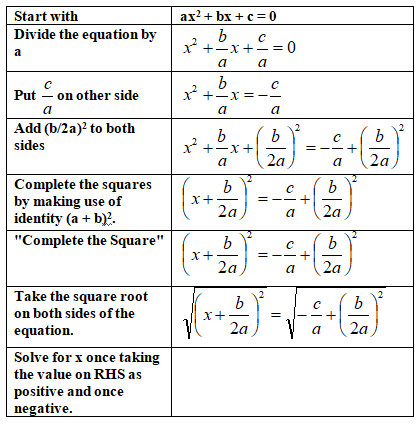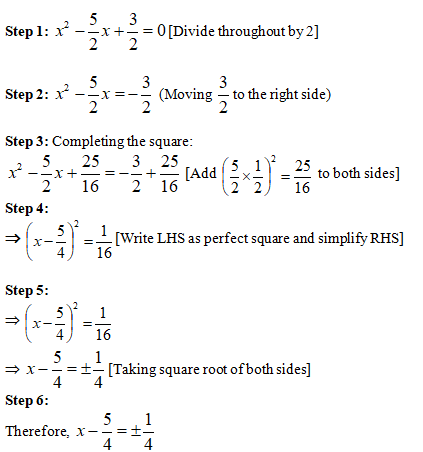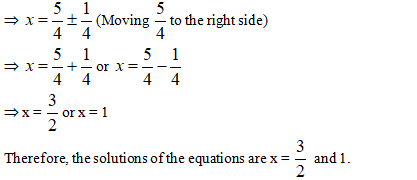In this blog, we will learn about Quadratic Equations, methods of solving a quadratic equation, and the quadratic formula with the help of solved examples. A quadratic equation is an equation that contains at least one squared variable. In our daily life, quadratic equations play a major role in calculating speed, figuring out the area, or determining profit.
What is a Quadratic Equation?
A quadratic equation in the variable x is an equation of the form ax2 + bx + c = 0, where
a, b, c are real numbers, a ? 0. Quadratic equation formula helps us solve quadratic equations.
Here is an example of quadratic equation; 5x2 - 3x + 3 = 0
The power 2 makes it quadratic. The name Quadratic comes from "quad" meaning Square, because the variable gets squared (like x2). But sometimes a quadratic equation doesn't look like that!
Standard Form of Quadratic Equation
This is the equation in disguise form x2 = 3x � 1,
Move all terms to left hand side,
In standard form x2 � 3x + 1, where a = 1, b = -3 and c = 1.
This equation is also in disguise form,
Multiply by x square,
We get the standard form of quadratic equation, 5x2 + x - 1 = 0
Where a = 5, b = 1 and c = -1
The standard form of a quadratic equation is ax2 + bx + c = 0, where a, b, and c are known values or coefficients but a is not equal to 0 and x is unknown or the variable.
Roots of Quadratic Equation: Roots of the quadratic equation are the values of x satifying the equation.
Solved Examples of Quadratic Equation
Represent this situation mathematically:
1. A cottage industry produces a certain number of toys in a day. The cost of production of each toy (in rupees) was found to be 55 minus the number of toys produced in a day. On a particular day, the total cost of production was Rs 750. We would like to find out the number of toys produced on that day.
Answer. Let the number of toys produced on that day be x.
Therefore, the cost of production (in rupees) of each toy that day = 55 � x
So, the total cost of production (in rupees) that day = x into (55 � x)
Therefore, x into (55 � x) = 750
i.e., 55x � x2 = 750
which implies � x2 + 55x � 750 = 0
this gives x2 � 55x + 750 = 0
Therefore, the number of toys produced that day satisfies the quadratic equation:
x2 � 55x + 750 = 0
Which is the required representation of the problem mathematically
How to solve quadratic equations?
Learn how to solve quadratic equation by two methods here, namely, factorization method and completing the square method.
�Solution of a Quadratic Equation by Factorisation�.
In general, a real number ? is called a root of the quadratic equation
ax2 + bx + c = 0, a ? 0
If a?2 + b? + c = 0, we also say that x = ? is a solution of the quadratic equation, or that ? satisfies the quadratic equation.
Remember: The zeroes of the quadratic polynomial ax2 + bx + c and the roots of the quadratic equation ax2 + bx + c = 0 are the same.
We know that a quadratic polynomial can have at most 2 zeros. So, any quadratic equation can have at most two roots.
Let us find the solution of a quadratic equation by factorisation, i.e., splitting the middle terms.
Quadratic Equations Examples
Example 1: Factorise 3x2 = 27.
Solution: 3x2 = 27
Subtracting 27 from both sides,
3x2 � 27 = 0
3 (x2 ? 9) = 0
3 (x ? 3) (x + 3) = 0
x ? 3 = 0 or x + 3 = 0
x = 3 or x = ?3
Example 2: Factorise x2 ? 5x + 6 = 0
Solution: x2 ? 5x + 6 = 0
?3�?2 = 6 � 3 + ?2 = ?5
So the two numbers are ?3 and ?2.
We use these two numbers to write ?5x as ?3x, � 2x and proceed to factorise as follows:
x2 � 5x + 6 = 0
= x2 � 3x � 2x + 6 = 0
= x (x � 3) � 2 (x � 3) = 0
= (x � 3) (x � 2) = 0
= x � 3 = 0 or x � 2 = 0
= x = 3 or x = 2
These are the two solutions.
Solving Quadratic Equations by Completing the Square
General Quadratic Equation is of the form ax square plus bx plus c is equal to 0
Where a is coefficient of x square, b is the coefficient of x and c is the constant term.
Let us solve it by Completing the Square.
Solving a Quadratic equation by the method of completing the square can be divided into following steps:


Quadratic Equations Examples
Example: Solve the quadratic equation by completing the square.
2x2 � 5x + 3 = 0
Solution: 2x2 � 5x + 3 = 0


Read More: Triangles: Types of Triangles, Formula & Triangle Properties


Leave your comment